语言学导论
- 格式:doc
- 大小:71.05 KB
- 文档页数:6
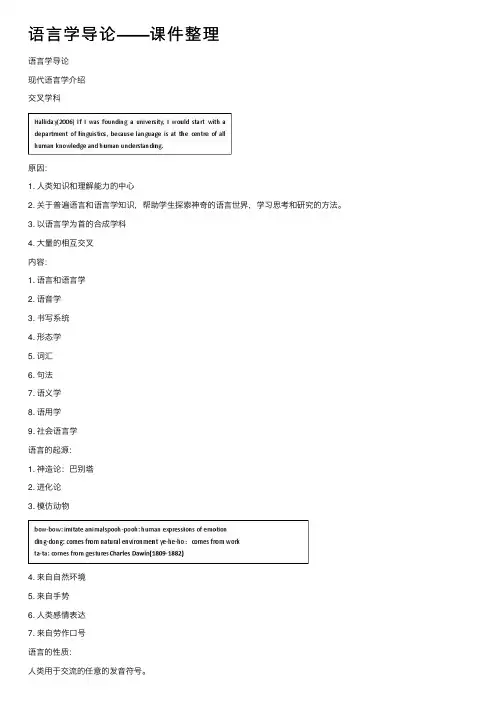
语⾔学导论——课件整理语⾔学导论现代语⾔学介绍交叉学科原因:1. ⼈类知识和理解能⼒的中⼼2. 关于普遍语⾔和语⾔学知识,帮助学⽣探索神奇的语⾔世界,学习思考和研究的⽅法。
3. 以语⾔学为⾸的合成学科4. ⼤量的相互交叉内容:1. 语⾔和语⾔学2. 语⾳学3. 书写系统4. 形态学5. 词汇6. 句法7. 语义学8. 语⽤学9. 社会语⾔学语⾔的起源:1. 神造论:巴别塔2. 进化论3. 模仿动物4. 来⾃⾃然环境5. 来⾃⼿势6. ⼈类感情表达7. 来⾃劳作⼝号语⾔的性质:⼈类⽤于交流的任意的发⾳符号。
⼀、语⾔是⼀种符号体系⼈们所指的物体与声⾳之间没有任何⾃然间的相似或联系。
社会习俗将词与物体、动作、观念联系起来,跨语⾔的社会习俗⼗分巨⼤。
1. 任意性2. 像似性理据:~语⾳学理据:。
拟声造字。
间接拟声构词(声⾳唤起动作)英语:PPT汉语:声象乎意;平声去声字意;声调不同意义改变,升调疑问,降调肯定;⼆、语⾔是⼀种交流的⼯具(思维)1)语⾔服从思维,是⼈类思想赖以表达的媒介或⼯具2)语⾔表达的思想具有可译性,不会⽤另⼀种语⾔来表达⽽损失其意义。
据说⼀种⼯具⼀经创造,它就独⽴于⼈甚⾄控制⼈和⼈的思维。
现在⼈服从语⾔。
现实的延伸取决于语⾔的发展。
语⾔制约着我们思考社会问题的⽅式。
……语⾔对思维的影响实例分析:1.特点:单⾳节字对应概念词影响:对仗⼯整,韵律节奏,表达模糊(上义词⽂化),统⼀辩证,同义反复思维极端,凑⾜⾳节识字重要所需要的能辨别意义的⾳节不多,不利于准确便捷的交际2.特点:双⾳节词3.特点:同义词影响:中国⽂化、政治和经济借以同⾳词⽽表现出特有的形式⽂化思维:诗歌,歇后语⽂化,谜语⽂化,⼴告⽂化,⼿机⽂化,外来词意译4.特点:形象思维(VS.抽象思维)影响:对事物的命名四字成语缺乏逻辑性三、语⾔是有系统的最基本的:声⾳与意义双重性语⾔的特征任意性线性离散性创造性(与双重性相关):低层:声⾳(⽆意义)⾼层:通过组合或重组的意义单元,可以组成⽆限的句⼦置换性(虚构)⽂化传递性语⾔分类1.遗传学分类(共同祖先—语系)2.类型分类(形态学的和句法结构)~形态结构:。
![语言学教程[第一章语言学导论]山东大学期末考试知识点复习](https://uimg.taocdn.com/948fb3732b160b4e777fcf0b.webp)
第一章语言学导论复习笔记Ⅰ.语言的定义语言是人类以口头交流的任意的符号系统。
该定义揭示了语言的五个要素:系统,任意,口头,符号,人类。
Ⅱ.语言的定义特征语言的定义特征是人类语言区别于其他动物交流系统的特点。
1.任意性任意性是语言的核心特征,是指符号的形式或者声音与意义之间没有逻辑或内在联系。
虽然语言从本质上讲是任意的,但也不是完全任意的。
一些词语,例如一些拟声词的发音与其意义还是有一定联系的。
2.二重性二重性是指拥有两层结构的这种属性,底层结构是上层结构的组成成分,每层都有自身的组合规则。
二重性只存在于这样的系统之中,既有元素又有它们组合成的单位。
3.创造性创造性指语言的能产性,它能够使人造出和理解无穷的长句,其中很多句子是以前从未听过的。
4.移位性移位性是指人类语言可以让使用者在交际时用语言符号代表时间上和空间上并不可及的物体、事件和观点。
移位性赋予人们的概括和想象力使人类受益无穷。
5.文化传递性语言不是靠遗传,而是通过文化传递的。
6.互换性互换性是指人可以是信息的发出者,也可以是信息的接受者,即人作为说话者和听话者的角色是可以随意更换的。
Ⅲ.语言的起源1.圣经的记载语言是上帝的恩赐。
2.“汪汪”理论语言是模仿自然的声音,例如动物的叫声,如 (鸭子)的刮刮声,嘎嘎声,布谷鸟的叫声。
3.“噗噗”理论语言来源于人本能的情感声音,表达疼痛或喜悦。
4.“哟一嘿一吼”理论语言起源于原始人共同劳动时发出的有节奏的哼哟声。
5.进化理论语言起源于劳动的过程,满足了社会的需求。
Ⅳ.语言的功能1.信息功能语言用来陈述某件事情,提供信息或用作推理。
信息功能是语言最重要的功能,一般出现在陈述句中。
2.人际功能人际功能是语言最重要的社会功能。
人们由此建立和维持他们的身份和社会地位。
3.施为功能语言的施为功能主要是用来改变人的社会地位,例如在婚礼、判刑,为孩子祈福和在首航仪式上为船命名、诅咒敌人。
在这些言语行为中,语言通常是非常正式的,甚至是仪式化的。
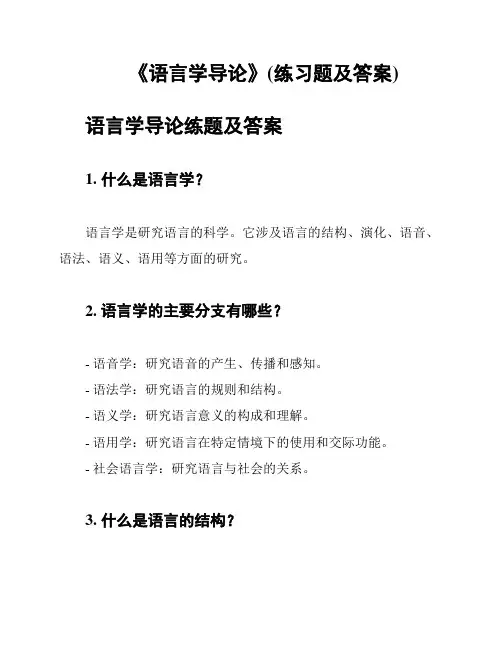
《语言学导论》(练习题及答案)语言学导论练题及答案1. 什么是语言学?语言学是研究语言的科学。
它涉及语言的结构、演化、语音、语法、语义、语用等方面的研究。
2. 语言学的主要分支有哪些?- 语音学:研究语音的产生、传播和感知。
- 语法学:研究语言的规则和结构。
- 语义学:研究语言意义的构成和理解。
- 语用学:研究语言在特定情境下的使用和交际功能。
- 社会语言学:研究语言与社会的关系。
3. 什么是语言的结构?语言的结构是指语言中各个层次(如语音、词汇、句子等)的组织方式和规则。
4. 语音学研究的是什么?语音学研究语音的产生、传播和感知。
它关注语音的音素、音位、音节以及音系等方面。
5. 语法学研究的是什么?语法学研究语言的规则和结构。
它涉及句子的构成和分析,包括词类、短语、句法关系等。
6. 语义学研究的是什么?语义学研究语言意义的构成和理解。
它关注词汇、句子和篇章层面的语义关系和意义表达。
7. 语用学研究的是什么?语用学研究语言在特定情境下的使用和交际功能。
它关注言语行为、话语策略和交际意图等。
8. 社会语言学研究的是什么?社会语言学研究语言与社会的关系。
它探讨语言在不同社会群体中的变化、语言的地位和使用情境等。
9. 语言学在日常生活中的应用有哪些?- 语言教育:帮助人们研究和教授语言。
- 语音技术:开发语音识别和合成等技术。
- 翻译和口译:促进不同语言之间的交流和理解。
- 语言规范:制定语法规则、文字标准等。
- 语义分析:帮助机器理解和处理自然语言。
10. 语言学为理解人类语言能力提供了哪些洞见?语言学研究揭示了语言是人类认知和交流的基本工具,提供了对语言产生、理解、学习和变化的深入认识。


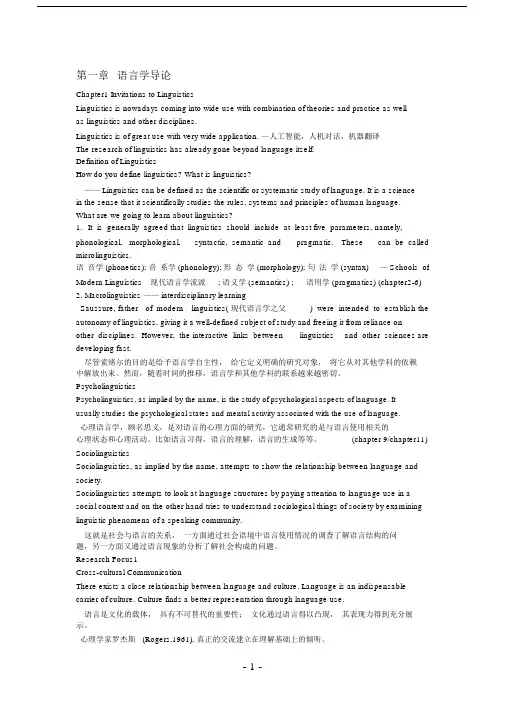
第一章语言学导论Chapter1 Invitations to LinguisticsLinguistics is nowadays coming into wide use with combination of theories and practice as wellas linguistics and other disciplines.Linguistics is of great use with very wide application. —人工智能,人机对话,机器翻译The research of linguistics has already gone beyond language itself.Definition of LinguisticsHow do you define linguistics? What is linguistics?—— Linguistics can be defined as the scientific or systematic study of language. It is a sciencein the sense that it scientifically studies the rules, systems and principles of human language.What are we going to learn about linguistics?1.It is generally agreed that linguistics should include at least five parameters, namely, phonological, morphological, syntactic, semantic and pragmatic. These can be called microlinguistics.语音学 (phonetics); 音系学 (phonology); 形态学 (morphology); 句法学 (syntax) — Schools of Modern Linguistics 现代语言学流派; 语义学 (semantics) ; 语用学 (pragmatics) (chapter2-6) 2. Macrolinguistics —— interdisciplinary learningSaussure, father of modern linguistics( 现代语言学之父) were intended to establish the autonomy of linguistics, giving it a well-defined subject of study and freeing it from reliance onother disciplines. However, the interactive links between linguistics and other sciences are developing fast.尽管索绪尔的目的是给予语言学自主性,给它定义明确的研究对象,将它从对其他学科的依赖中解放出来。
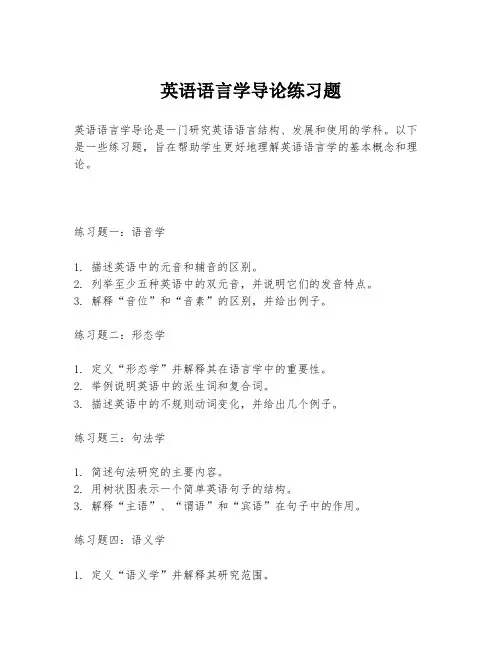
英语语言学导论练习题英语语言学导论是一门研究英语语言结构、发展和使用的学科。
以下是一些练习题,旨在帮助学生更好地理解英语语言学的基本概念和理论。
练习题一:语音学1. 描述英语中的元音和辅音的区别。
2. 列举至少五种英语中的双元音,并说明它们的发音特点。
3. 解释“音位”和“音素”的区别,并给出例子。
练习题二:形态学1. 定义“形态学”并解释其在语言学中的重要性。
2. 举例说明英语中的派生词和复合词。
3. 描述英语中的不规则动词变化,并给出几个例子。
练习题三:句法学1. 简述句法研究的主要内容。
2. 用树状图表示一个简单英语句子的结构。
3. 解释“主语”、“谓语”和“宾语”在句子中的作用。
练习题四:语义学1. 定义“语义学”并解释其研究范围。
2. 描述“同义”和“反义”的概念,并给出英语例子。
3. 解释“语境”如何影响语言的意义。
练习题五:语用学1. 什么是语用学?它与语义学有何不同?2. 描述“指示语”、“礼貌原则”和“合作原则”在交际中的作用。
3. 举例说明如何在不同的社交场合中使用不同的语言风格。
练习题六:社会语言学1. 解释社会语言学研究的主要内容。
2. 讨论语言变异与社会身份之间的关系。
3. 描述双语现象及其对语言使用者的影响。
练习题七:心理语言学1. 心理语言学是如何研究语言的?2. 描述“语言习得”的过程及其理论。
3. 讨论“母语”和“第二语言”学习之间的差异。
练习题八:历史语言学1. 定义“历史语言学”并解释其研究目的。
2. 描述英语的发展历史和主要变化。
3. 讨论语言接触和借用对语言发展的影响。
完成这些练习题将有助于加深对英语语言学各个方面的理解,并提高分析和应用语言学理论的能力。
希望这些练习题能对你的学习有所帮助。

一、语言学总论1. design feature of language(语言的定义特征)defining properties of human language that distinguish it from any animal system of communication1)Arbitrariness(任意性): 象似性iconicity定义:the forms of linguistic signs bear no natural relationship to their meaning.举例:书, book, livre喜欢,like,aimer2)Duality(二层性):定义:the property of having two levels of structures, such that units of the primary level are composed of elements of the secondary level.举例:Sounds > syllables > words > phrases > clauses > sentences> texts/discourses3)Creativity/Productivity(创造性):定义:Language can be used to create new meanings because of its duality.举例1:/k/ ,/a:/, /p/---- carp or park举例2:England, defeated, FranceEngland defeated France.France defeated England.4)Displacement(替代性、移位性):定义:Human languages enable their users to symbolize something which are not present at the moment of communication.5)Cultural Transmission(文化传递性):定义:language is passed on from generation to generation through teaching and learning rather than instinct.反例:印度狼孩2. Important Distinctions in Linguistics(语言学研究中几对重要的概念)1) Descriptive (描述性)vs. Prescriptive (规定性)Descriptive: describing how things are.prescriptive: prescribing how things ought to beImportant Distinctions in Linguistics举例:Don't say X.People don't say X.The first is a prescriptive command, while the second is a descriptive statement.2). Synchronic(共时性)vs. Diachronic (历时性)synchronic: takes a fixed instant as its point of observation.diachronic: the study of a language through the course of its history.举例:研究1800年的英语发音Synchronic studies (共时性研究)研究1800-1900的法语语法变化Diachronic studies (历时研究)3). langue(语言)& parole (言语)Theorist:Saussure(索绪尔), father of modern linguisticslangue: abstract linguistic systemparole: actual realization of langueImportant Distinctions in Linguistics4) Competence(语言能力)and performance (语言运用)theorist: Chomsky(乔姆斯基)competence: user's knowledge of rules about the linguistic system.performance: the actual realization of this knowledge in concrete situations.二、语音学和音系学1.语音学(phonetics)和音系学(phonology)的定义和区别2.语音学重要概念: 清音和浊音3.音系学重要概念: 音子,音位, 超音段特征Phonetics studies all speech sounds in human languages: how they are produced, transmitted and how they are received.Phonology: aims to discover how speech sounds in a language form patternsand how these sounds are used to convey meaning in linguistic communication.区别: meaning(是否研究和表达意义有关的语音)举例:too 和tea 中的/t/发too中的/t/时, 舌位更靠近口腔前部发tea中的/t/时,舌位更靠近口腔后部语音学要研究这种/t/发音的不同之处, 音系学不研究语音学分类articulatory phonetics(发音语音学): speakers productionacoustic phonetics(声学语音学): transmission’s mediumauditory phonetics(听觉语音学): receiver’s receptionHow speech sounds are madeSpeech organsPosition of the vocal folds(声带): voicing(浊音) and voiceless (清音)Voiceless(清音):vocal cords are drawn wide apart, letting the air stream go through without causing obstruction清音举例:[p,s,t]Voicing/Voiced(浊音):vocal cords held together, letting the air stream vibrates浊音: [b,z,d]The distinction between vowels and consonants lies in the obstruction of air stream.As there is no obstruction of air in the production of vowels, the description of the consonants and vowels cannot be done along the same lines.音系学重要概念:Phone(音子):a phonetic unit; the speech sounds we hear and produce during communication are all phones举例:too 和tea 中的/t/发too中的/t/时, 舌位更靠近口腔前部发tea中的/t/时,舌位更靠近口腔后部所以too 和tea 中的/t/两个不同的音子Phoneme(音位): phonological and abstract unit, a unit of distinctive value;the smallest unit of sound in a language which can distinguish two words.举例:tea 和sea, /t/和/s/是两个不同的音位morphemeSuprasegmental features (超音段特征)Suprasegmental features: phonemic features that occur above the level of the segments .The principal suprasegmentals are:stress (重音)举例: perfect (adj) 和perfect (v)tone (声调)/pitch (音高):定义: sound feature which are caused by the differing rate of vibration of the vocal folds.举例: mā妈, má麻, mă马,mà骂比较:英语单词,如meintonation (语调):pitch, stress, and sound length are tied to the sentence rather than the word in isolation.三、Morphology 形态学1. 学科定义2. 语素的定义和分类3. 词的分类(classification of words)形态学研究的基本单位1. morpheme(语素). The most basic element of meaning in language,an element that cannot be further divided into smaller units without altering its meaning.举例:ballfootballballsTypes of MorphemesFree morphemes vs. Bound morphemes(自由语素和黏着语素):Free morphemes: those that may constitute words by themselves, eg boy, girl, table, nation. Bound morphemes: those that cannot occur alone, eg -s, -ed, dis-, un-.Types of Bound MorphemeInflectional morpheme (屈折语素)=inflectional affix(屈折词缀):change the grammatical meaning (number, aspect, case, tense)Derivational morpheme(派生语素)=derivational affix (派生词缀): change the lexical meaningDerivational morpheme(改变词义):改变词义:dis-, un-, multi-, micro-改变词性:en-, -full, -mentInflectional morpheme(改变语法含义):改变名称的性,数,格:-ess, -s,改变动词的时, 态,体: -ing, -ed,改变形容词的级:-er, -est如何区分派生词(derivational word)和合成词(compound word) : 拆开后看各个组成的语素能否都单独成词,如果可以,就是合成词,如果不能就是派生词。
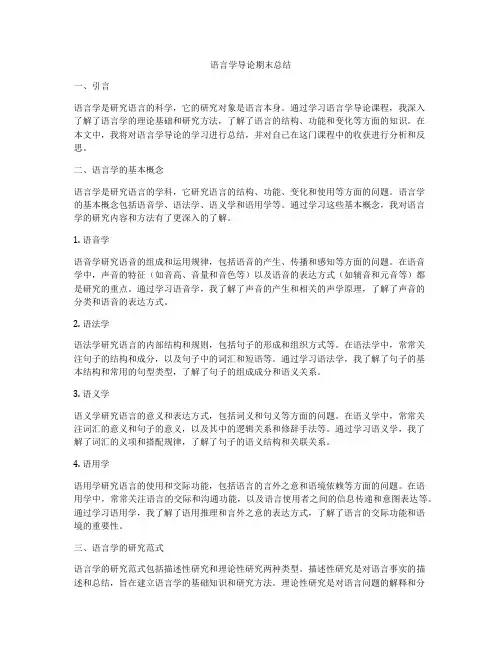
语言学导论期末总结一、引言语言学是研究语言的科学,它的研究对象是语言本身。
通过学习语言学导论课程,我深入了解了语言学的理论基础和研究方法,了解了语言的结构、功能和变化等方面的知识。
在本文中,我将对语言学导论的学习进行总结,并对自己在这门课程中的收获进行分析和反思。
二、语言学的基本概念语言学是研究语言的学科,它研究语言的结构、功能、变化和使用等方面的问题。
语言学的基本概念包括语音学、语法学、语义学和语用学等。
通过学习这些基本概念,我对语言学的研究内容和方法有了更深入的了解。
1. 语音学语音学研究语音的组成和运用规律,包括语音的产生、传播和感知等方面的问题。
在语音学中,声音的特征(如音高、音量和音色等)以及语音的表达方式(如辅音和元音等)都是研究的重点。
通过学习语音学,我了解了声音的产生和相关的声学原理,了解了声音的分类和语音的表达方式。
2. 语法学语法学研究语言的内部结构和规则,包括句子的形成和组织方式等。
在语法学中,常常关注句子的结构和成分,以及句子中的词汇和短语等。
通过学习语法学,我了解了句子的基本结构和常用的句型类型,了解了句子的组成成分和语义关系。
3. 语义学语义学研究语言的意义和表达方式,包括词义和句义等方面的问题。
在语义学中,常常关注词汇的意义和句子的意义,以及其中的逻辑关系和修辞手法等。
通过学习语义学,我了解了词汇的义项和搭配规律,了解了句子的语义结构和关联关系。
4. 语用学语用学研究语言的使用和交际功能,包括语言的言外之意和语境依赖等方面的问题。
在语用学中,常常关注语言的交际和沟通功能,以及语言使用者之间的信息传递和意图表达等。
通过学习语用学,我了解了语用推理和言外之意的表达方式,了解了语言的交际功能和语境的重要性。
三、语言学的研究范式语言学的研究范式包括描述性研究和理论性研究两种类型。
描述性研究是对语言事实的描述和总结,旨在建立语言学的基础知识和研究方法。
理论性研究是对语言问题的解释和分析,旨在建立语言学的理论体系和解释框架。
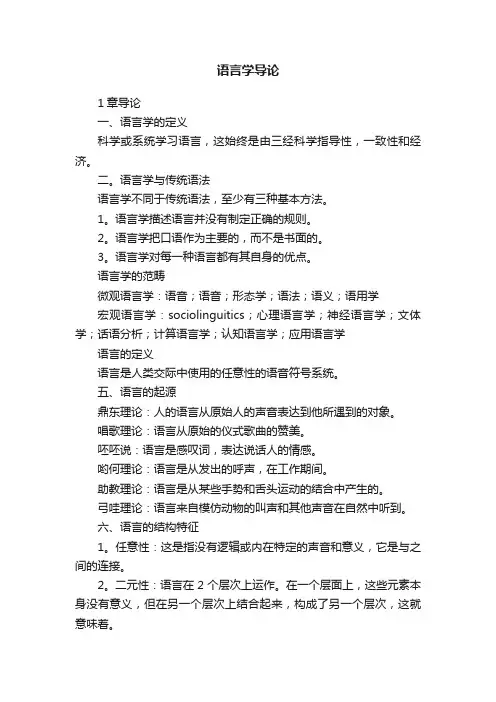
语言学导论1章导论一、语言学的定义科学或系统学习语言,这始终是由三经科学指导性,一致性和经济。
二。
语言学与传统语法语言学不同于传统语法,至少有三种基本方法。
1。
语言学描述语言并没有制定正确的规则。
2。
语言学把口语作为主要的,而不是书面的。
3。
语言学对每一种语言都有其自身的优点。
语言学的范畴微观语言学:语音;语音;形态学;语法;语义;语用学宏观语言学:sociolinguitics;心理语言学;神经语言学;文体学;话语分析;计算语言学;认知语言学;应用语言学语言的定义语言是人类交际中使用的任意性的语音符号系统。
五、语言的起源鼎东理论:人的语言从原始人的声音表达到他所遇到的对象。
唱歌理论:语言从原始的仪式歌曲的赞美。
呸呸说:语言是感叹词,表达说话人的情感。
哟何理论:语言是从发出的呼声,在工作期间。
助教理论:语言是从某些手势和舌头运动的结合中产生的。
弓哇理论:语言来自模仿动物的叫声和其他声音在自然中听到。
六、语言的结构特征1。
任意性:这是指没有逻辑或内在特定的声音和意义,它是与之间的连接。
2。
二元性:语言在2个层次上运作。
在一个层面上,这些元素本身没有意义,但在另一个层次上结合起来,构成了另一个层次,这就意味着。
3。
生产力:生产力或创造力是指人的语言能力,使他能够产生和理解一个无限大量的句子在我们的母语。
4。
互换:互换性和互惠性是指人能够产生和接收的信息,和他作为一个演讲者和听众可以交换安心的角色。
5。
位移:位移是一种语言的特性,使人们可以在空间或时间上谈论事情的遥远。
6。
专业化:专业化指的是,人在沟通的过程中没有完全的身体参与。
7。
文化传播:语言是文化传播的。
它不能通过遗传传递。
七。
语言功能1。
交际功能/交流:语言是用来建立一个气氛或保持说话人和听话人之间的社会联系。
问候、告别和天气服务这一功能的评论。
2。
指令功能:语言是用来让听话人做某事。
最重要的句子是这个函数。
3。
信息功能:语言是用来告诉一些东西,给信息,或是对事物的原因。

新编语言学导论新编语言学导论是一门综合性的学科,研究语言的起源、结构、演化和使用等方面的问题。
本课程旨在向学生介绍语言学的基本概念、理论和研究方法,帮助学生建立对语言的深入理解和分析能力。
第一章:导论1.1 语言学的定义和研究领域1.2 语言学的历史发展和重要学派1.3 语言学的研究方法和数据来源第二章:语音学2.1 语音学的基本概念和研究对象2.2 语音的产生和感知2.3 语音的分类和描述2.4 语音变体和语音变体学第三章:音位学3.1 音位学的基本概念和研究对象3.2 音位的分类和描述3.3 音位的组合和变体3.4 音位学与音系学的关系第四章:词汇学4.1 词汇学的基本概念和研究对象4.2 词的构成和分类4.3 词的意义和语义关系4.4 词汇的演化和变化第五章:句法学5.1 句法学的基本概念和研究对象5.2 句子的结构和组成5.3 句子的语法关系和句法规则5.4 句法的演化和变化第六章:语义学6.1 语义学的基本概念和研究对象6.2 词义的分类和描述6.3 句义的组成和解释6.4 语义的演化和变化第七章:语用学7.1 语用学的基本概念和研究对象7.2 语用的层次和关系7.3 言语行为和语用推理7.4 语用的演化和变化第八章:社会语言学8.1 社会语言学的基本概念和研究对象8.2 语言变体和社会变量8.3 语言的社会意义和社会身份8.4 社会语言学的应用和研究方法第九章:心理语言学9.1 心理语言学的基本概念和研究对象9.2 语言的认知过程和心理机制9.3 语言的发展和习得9.4 心理语言学的应用和研究方法第十章:语言学研究的前沿和挑战10.1 当代语言学的研究热点和趋势10.2 语言学研究的跨学科合作10.3 语言学研究的伦理和道德问题10.4 语言学研究的未来发展方向本课程将通过理论讲解、案例分析和实践操作等多种教学方法,帮助学生理解和应用语言学的基本原理和方法,培养学生的批判性思维和研究能力,为进一步深入研究语言学或相关学科打下坚实的基础。
语言学导论复习资料一:名词解释(4个)ngue & Parole(语言与言语)Langue is the linguistic competence of the speaker,which is relatively stable and systematic and also the rule that the speaker should follow.Parole is the actual phenomena or data of linguistics, which is subject to personal and situational constraints and always a naturally occurring event.2.Phonetics & Phonology (语音学与音位学)Phonetics is the study of speech sounds, including three main areas: articulatory phonetics (发音语音学), acoustic phonetics(声学语音学), auditory Phonetics(听觉语音学).Phonology is the study of sound systems—the invention of distinctive speech sounds that occur in a language and the patterns.3.Open-class word & Closed-class word(开放类词与封闭类词)Open-class words: whose membership is in principle infinite or unlimited.e.g. n. v. adj. adv.E.g. regarding / with regard to ; throughout, in spite ofClosed words : their membership is fixed or limited.E.g. pro. prep. conj. art. etc.4. Immediate Constituent Analysis(直接成分分析法)The relation between a sentence and its component elements is a Construction(结构体)and its Constituents(成分). To analyze their relations is IC.5. Sense & Reference(意义与所指)Sense: The literal meaning of a word or an expression, independence of situational context. Reference: The relation between words and the things, actions, events and qualities they stand for.6. Metaphor & Metonymy (隐喻与转喻)Metaphor involves the comparison of two concepts in that one is construed in terms of the other.E.g. All the world is a stage.Metonymy : in the cognitive literature, is defined as a cognitive process in which the vehicle provides mental access to the target within the same domain.E.g. the crown can stand for a king, and the White House for the American government.7. Performatives & Constatives(施为句与表述句)Performatives: In speech act theory an utterance which performs an act, such as Watch out. Constatives: An utterance which asserts something that is either true or false. E.g. Chicago is in the United States.二:问答题(3个)1.What are the designed features of Language?“Design features”here refer to the defining properties of human language that tell the difference between human language and any system of animal communication, including:1. Arbitrariness refers to the fact that the forms of linguistic signs bear no natural relationship to their meanings.2. duality refers to the property of having two levels of structures.3. creativity means that language is resourceful because of its duality and recursiveness.(递归性)4. displacement means that human languages enable their users to symbolize objects, events and concepts which are not present at the moment of communication.5. Cultural Transmission means that language is not biologically transmitted from generation to generation, but that the details of the linguistic system must be learned by each speaker.2.What is Iconicity(句法像似性)?How to analyze some language phenomena with Iconicity?In functional-cognitive linguistics, as well as in semiotics, iconicity is the conceived similarity or analogy between the form of a sign and its meaning, as opposed to arbitrariness.We can analyze some language phenomena with the Iconic principles.①Proximity principle: conceptual distance tends to match with linguistic distance, e.g. “give sb sth” and “give sth to sb”②Quantity principle: conceptual complexity corresponds to formal complexity, e.g. “apple, tree”, “apple tree” and “apple trees”.③Sequential order principle: the sequential order of events described is mirrored in the speech chain, e.g. “I came, I saw, I conquered”.3.What is prototype theory(原形范畴)? How to analyze some language phenomena with prototype theory?Prototype theory is a mode of graded categorization in cognitive science, where some members of a category are more central than others. For example, when asked to give an example of the concept furniture, chair is more frequently cited than, say, stool.We can analyze some language phenomena with its three levels in categories.①basic level: This is the level where we perceive the most differences between “objects” in the word. E.g, all categories of dogs are different, but they still share enough to be distinguished from cats, birds, snakes,etc.②superordinate level: Superordinate categories are the most general ones. E.g, if someone asks you to think of a plant, you might think of a tree or a flower.③subordinate level: They have clearly identifiable gestalts(完形)and lots of individual specific features. At this level we perceive the differences between members od the basic level categories, like rain coat,apple juice and wheel chair.4.What is figure and ground theory? How to analyze some language phenomena with figure and ground theory?The figure within a scene is a substructure perceived as "standing out" from the remainder(the ground) and accorded special prominence as the pivotal(关键的)entity around which the scene is organized and for which it provides a setting. For example, you see words on a printed paper as the "figure" and the white sheet as the "background".It is believed that the selection and arrangement of the information in syntactic structure are decided by the degrees of salience of it. For example, “The car crashed into the tree” and “The tree was hit by the car”, in these two sentences, the meanings are the same, but by arranging the positions of the subject and object differently, the focus and prominence are different.5.How to analyze some language phenomena with Metaphor and Metonymy? We can analyze some language phenomena with metaphor through its three categories.1.Ontological metaphor: e.g inflation is backing us to conner.In this sentence, regarding inflation as an entity allows human beings to refer to it, identify it, treat it as a case.2.Structural metaphor imply how one concept is metaphorically structured in terms of another. For example, “Argument is war”leads to an English expression like “Your claims are indefensible”.3.Orientional metaphor gives a concept a spatial orientation.For example, “I’m feeling up” shows erect posture is related with a positive state, and vise versa.6. What is Speech Act theory? What is Illocutionary Act? What is Cooperative Principle?The speech act theory was originated with John Austin. A speech act is an utterance that has performative function in language and communication. Speech acts are commonly taken to include such acts as promising, ordering, greeting, warning, etc.Illocutionary act means when we speak, we not only produce some units of language with certain meanings, but also make clear our purpose in producing them, the way we intend them to be understood, or they also have certain forces.Cooperative Principle refers to the “co-operation” between speakers in using the maxims during the conversation. There are four conversational maxims: the maxim of quantity, the maxim of quality, the maxim of relation, the maxim of manner.三.语言学家及其理论、作品配对1.Saussure: Course in General Linguistics 结构主义历时研究diachronic study2.Boas: discovered the framework of descriptive linguistics Handbook of American Indian languages3.Sapir: Sapir-Whorf Hypothesis Language4.Bloomfield: stimulus-response theory Language(1993)5.Malinowski: context of situationCoral Gardens and Their Magic6.Trubetzkoy: Principles of Phonlogy7.Austin: speech act theory How to do things with words8.Grice: the cooperative principle Logic and conversation9.Halliday: systemic-functional grammarthe theory of metafunctions of language(元语言功能理论)10.Chomsky: language acquisition device(LAD) generative grammar Syntactic Structureskoff: cognitive linguistics Metaphors We Lived By12.Leech: 7 types of meaning in his Semantics13.Ogden & Richards: Semantic Triangle四.选择题,判断题重点1. Language is a system of arbitrary vocal symbols used for human communication.2. 语言的起源:the bow-wow theory, the pooh-pooh theory, the yo-he-yo theory.3. 语言的功能:interpersonal function(人际功能),performative function(行事),emotive,expressive,phatic communication(寒暄),recreational,metalingual.4. 语言学的主要分支:phonetics[articulatory, acoustic(physical properties), auditory], phonology, morphology, syntax, semantics, pragmatics.5. 语音属于言语,音位属于语言,音位(phoneme)是最小的语音单位,语素(morpheme)是语法意义中最小的语言单位,单词(word)是语言最小的自由单位。
Chapter 1 Introduction介绍1.语言定义What is languageLanguage is a system of arbitrary vocal symbols used for human communication.First, language is a system, i.e. elements of language are combined according to rules. This explains why “iblk” is not a possible sound combination in English, and also why “Been he wounded has” is not a grammatically acceptable sentence in English.Second, language is arbitrary in the sense that there is no intrinsic connection between a linguistic symbol and what the symbol stands for, for instance, between the word “pen” and the thing we write with. Different languages have different words for the same object. Words are just symbols. “A rose by any other name would smell as sweet.” Shakespeare’s play “Romeo and Juliet”.Third, language is vocal because the primary medium for all languages is sound. All evidence points to the fact that writing systems came into being much later than the spoken forms and that they are only attempts to capture sounds and meaning on paper. The fact that children acquire spoken language before they can read or write also indicates that language is primarily vocal.2. 语言特征Design Features of LanguageDesign features refer to the defining properties of human language that distinguish it from any animal system of communication.Charles Hockett (American) in 1960 : (5 of 13)①Arbitrariness 任意性: There is no logical connection between meanings and sounds.(A good example is the fact that different sounds are used to refer to the same object in different languages.) On the other hand, language is not entirely arbitrary, such like onomatopoeic words and some compound words.②Productivity 多产性: Language is productive or creative in that it makes possible the construction and interpretation of new signals by its users.③Duality 双重性: Language is a system, which consists of two levels. The basic level is a structure of sounds, and the higher level is the units of meaning.④Displacement 移位性: Language can be used to refer to contexts removed from the immediate situations of the speaker.⑤Cultural transmission 文化传承性: Language is passed on from one generation to the next through teaching and learning, rather than by instinct.3.语言功能Function of LanguageThree main functions : the descriptive function, the expressive function and the social function.①The descriptive function: also referred to differently as the cognitive, or referential, or propositional function, is assumed to be the primary function of language.It is the function to convey factual information, which can be asserted or denied, and in some cases even verified.②The expressive function: also called the emotive or attitudinal function, supplies information about the user’s feelings, preferences, prejudices, and values.③The social function: also referred to as the interpersonal function, serves to establish and maintain social relations between people.Roman Jakobson (Russian-born) :He identifies six elements of a speech event and relates each one of them to one specific language function.①Addresser, Emotive 情感功能The addresser expresses his attitude to the topic or situation of communication.②Addressee, Conative 意动功能The addresser aims to influence the addressee’s course of action or ways of thinking.③Context, Referential 信息功能The addresser conveys a message of information.④Message, Poetic 诗性功能The addresser uses language for the sole purpose of displaying the beauty of language itself.⑤Contact, Phatic communication 寒暄功能The addresser tries to establish or maintain good interpersonal relationship with the addressee.⑥Code.Metalinguistic 元语言,纯理功能The addresser uses language to make clear the meaning of language itself, e.g. “Let me tell you what the word ‘linguist’ means.”M.A.K. Halliday (British) in the early 1970s :He explored the functions of child language, and found that as a child grew into an adult the7 functions are gradually replaced by a more abstract system of functions.①Ideational 经验功能: The ideational function is to organize the speaker or writer’sexperience of the real or imaginary world. It corresponds closely to the descriptive function, but it is broader because it also includes the expression of the speaker’s attitude, evaluation, his feelings and emotions.②Interpersonal 人际功能: The interpersonal function is to establish or maintain socialrelationships between people.③Textual 语篇功能: The textual function is to organize written or spoken texts in such amanner that they are coherent within themselves and fit the particular situation in which they are used.4.语言学定义What is LinguisticsLinguistics is generally defined as the scientific study of language.(Linguistics studies not any particular language, but it studies languages in general.)(It is a scientific study because it is based on the systematic investigation of linguistic data, conducted with reference to some general theory of language structure.)5.语言学范围the scope of linguisticsRelatively independent branches within the area of linguistics, and also the core of linguistics:①Phonetics语音学: The study of sounds used in linguistic communication.②Phonology音位学: how sounds are put together and used to convey meaning in communication.③Morphology形态学: The study of the way in which symbols are arranged and combined to form words.④Syntax 句法学: the study of rules that govern the combination of words to form grammatically permissible sentences in languages.⑤Semantics语义学: In most general terms language is used to convey meaning. The study of meaning is known as semantics.⑥Pragmatics语用学: Language communication does not occur in a vacuum, it always occurs in a context. The study of meaning in the context of language use is called pragmatics. Interdisciplinary branches of linguistic study: sociolinguistics社会语言学psycholinguistics 语言心理学applied linguistics 应用语言学。
国家级一流课程线下课程语言学导论一、课程简介语言学导论是一门关于语言学基本理论和方法的课程,旨在帮助学生建立对语言学的基本概念和理论的认识,提高对语言学研究的兴趣和理解。
本课程将涵盖语言学的基本概念、语音学、形态学、句法学、语义学等内容,通过理论讲解和案例分析,引领学生深入了解语言学的相关知识,为今后的语言学研究和应用工作打下坚实的基础。
二、课程目标本课程旨在通过深入讲解语言学的基本理论和方法,培养学生的语言分析能力和研究思维,达到以下目标:1. 帮助学生建立对语言学基本概念和理论的认识,掌握语言学的基本知识和研究方法;2. 培养学生分析语言现象和问题的能力,提高学生的语言思维和逻辑思维能力;3. 引导学生加强对语言学研究的兴趣和理解,为学生今后深入学习和研究语言学打下基础。
三、课程内容和教学安排本课程将主要涵盖以下内容:1. 语言学基本概念:介绍语言学的基本概念、语言的定义、语言系统的组成等;2. 语音学:讲解语音学的基本理论和方法、语音学的研究内容和重要性等;3. 形态学:介绍词汇的构词规律、词的形态结构、词汇的分类等;4. 句法学:讲解句子的成分、句子的结构、句法规律等;5. 语义学:介绍语言的意义和语义关系、语言的逻辑结构、语言的语用等。
教学安排将以理论讲解、案例分析、课堂讨论等形式展开,每周安排2节课,每节课90分钟。
鼓励学生阅读相关学术文献和案例,加深对语言学理论和方法的理解和应用。
四、教学方法和手段为了达到良好的教学效果,本课程将采用多种教学方法和手段:1. 理论讲解:通过系统的理论讲解,帮助学生建立对语言学基本概念和理论的认识;2. 案例分析:通过实际案例分析,引导学生深入理解语言学理论和方法的应用;3. 课堂讨论:鼓励学生积极参与课堂讨论,共同探讨语言学理论和方法的研究问题;4. 学术文献阅读:安排学生阅读相关学术文献,拓宽学生对语言学理论和方法的认识。
通过多种教学方法和手段的有机结合,引导学生主动参与学习,提高学习兴趣和效果。
应用语言学导论语言学是研究语言的科学,它探讨的不仅是我们日常交流所使用的工具,更是人类思维和文化的反映。
通过深入了解语言学导论,我们可以更好地理解语言的本质,提升我们的语言能力,并且对语言学的实际应用有更深入的认识。
首先,语言学导论帮助我们理解语言的基本概念。
语言是人类交流的工具,通过声音、文字等形式表达思想和感情。
语言学导论介绍了语言的基本要素,包括语音、词汇、语法和语用等方面。
通过学习这些基本概念,我们可以更好地理解语言的结构和运作方式。
其次,语言学导论帮助我们认识不同语言之间的差异。
世界上有各种各样的语言,每种语言都有自己独特的语音、词汇和语法规则。
语言学导论可以帮助我们比较不同语言之间的差异,了解它们的特点和文化背景。
这对于学习外语和跨文化交流至关重要,帮助我们避免语言误解和文化冲突。
此外,语言学导论提供了语言变化和语言演化的知识。
语言是一种活的系统,不断变化和演化。
通过学习语言学导论,我们可以了解语言变化的原因和过程。
从历史语言学角度看,我们可以了解语言是如何从古代演化至今的,并且可以预测未来语言的可能变化。
这对于我们理解语言的发展和变化规律非常重要。
除了以上内容,语言学导论还介绍了语言应用领域的重要性。
语言学的研究对于教育、翻译、语音识别、自然语言处理等领域都有重要的应用价值。
学习语言学导论可以帮助我们了解这些应用的原理和方法,并且为从事相关工作提供了基础知识和技能。
总之,语言学导论是一门非常有意义和实用的学科。
通过学习语言学导论,我们可以更好地理解和运用语言,提高我们的语言能力和跨文化交流能力。
无论是对于语言爱好者还是从事相关行业的人士,都会从中受益匪浅。
因此,我鼓励大家学习语言学导论,探索语言的奥秘,拓宽自己的知识领域。
语言学导论一What is LanguageLanguage is a system of arbitrary vocal symbols used for human communication. To give the briefest definition, language is a means of verbal communication. Language distinguishes us from animals because it is far more sophisticated than any animal communication system.二Design Features of Language一)ArbitrarinessThe widely accepted meaning of this feature, which was first discussed by Saussure, refers to the fact that the forms of linguistic signs bear no natural relationship to their meaning. For instance, we cannot explain why a book is called /buk/.二)DualityIt means the property of having two levels of structures, such that units of the primary level are composed of elements of the secondary level and each of the two levels has its own principles of organization.三)CreativityBy creativity we mean language is resourceful because of its duality and its recursiveness. One of the reasons why language is actually a far more complicated entity is that we can use it to create new meanings.四)DisplacementDisplacement means that human languages enable their users to symbolize objects, events and concepts, which are not present (in time and space) at the moment of communication. For example, we can refer to Confucious or the North Pole, even though the first has been dead for 2,500 years and the second is situated far away.练习:1、Which of the following statements about language is NOT true?A. Animals also have languages.B. Language is a system.C. Language is arbitraryD. Language is symbolic.正确答案:Animals also have languages.2、Productivity is one of the _____ features of languages.A. DesignB. DistinctiveC. PragmaticD. Superasegmental正确答案:designFunctions of Language一)InformativeIt is the major role of language. The use of language to record the facts is a prerequisite of social development.It is also ideational function in the framework of functional grammar.二)Interpersonal FunctionIt is the most important sociological use of language, by which people establish and maintain their status in a society.Attached to the interpersonal function of language is its function of the expression of identity.三)PerformativeThis concept originates from the philosophical study of language presented by Austin and Searle, whose theory now forms the backbone of pragmatics.The performative function of language is primarily to change the social status of persons as in marriage ceremonies, the blessing of children and the naming of a ship at a launching ceremony. The kind of language employed in performative verbal acts is usually quite formal and even ritualized.四)Emotive FunctionThe emotive function of language is one of the most powerful uses of language because it is so crucial in changing the emotional status of an audience for or against someone or something. e.g. God, My, Damn it ......五)Phatic CommunionThe term originates from Malinowski's study of the function of language performed by Trobriand Islanders. It refers to the social interaction of language.We all use small, seemingly meaningless expressions such as Good morning, God bless you, Nice day to maintain a comfortable relationship between people. 六)Recreational FunctionNo one will deny the use of language for the sheer joy of using it such as baby's babbling or a chanter's chanting.七)Metalingual FunctionOur language can be used to talk about itself. For example, we can use the word "book" to talk about a book.What is Linguistics?Linguistics is a branch of science, which takes language as its object of investigation.Main Branches of Linguistics一)PhoneticsPhonetics studies speech sounds, including the production of speech, that is how speech sounds are actually made, transmitted and received, the sounds of speech, the description and the classification of speech sounds, words and connected speech, etc.二)PhonologyPhonology studies the rules governing the structure, distribution and sequencing of speech sounds and the shape of syllables. It deals with the sound systems of a language by treating phonemes as the point of departure.三)MorphologyMorphology is concerned with the internal organization of words. It studies the minimal units of meaning—morphemes and word-formation processes.四)SyntaxSyntax is about principles of forming and understanding correct English sentences.五)SemanticsSemantics examines how meaning is encoded in a language. It is not only concerned with meanings of words as lexical items, but also with levels of language below the word and above it, e.g. meaning of morphemes and sentences.六)PragmaticsPragmatics is the study of meaning in context. In other words, it is concerned with the way language is used to communicate rather than with the way language is structured.练习:1、Which branch of study cannot be included in the scope of Lingustics?A. AnthropologyB. PhoneticsC. PragmaticsD. Syntax正确答案:Anthropology2、______ is the study of the relationship between symbols and their interpreter.A. PragmaticsB. SemanticsC. SociolinguisticsD. Syntax正确答案:Pragmatics3、____ is concerned with the study of the actual use of language in communication.A. PragmaticsB. SemanticsC. SociolinguisticsD. Synchronic linguistics正确答案:Pragmatics4、Once the notion of _____ was taken into consideration, semantics spilled into pragmatics.A. ContentB. ContextC. FormD. Meaning正确答案:context5、_____ is the major concern of semantics.A. MeaningB. Phrase structure rulesC. Sentence structuresD. Words正确答案:MeaningMacrolinguistics一)PsycholinguisticsPsycholinguistics investigates the interrelation of language and mind, in processing and producing utterances and in language acquisition. The psychological constraints on the form of grammar are studied. It also studies language development in the child, biological foundations of language and the relationship between language and cognition.二)SociolinguisticsSociolinguistics is the study of the characteristics of language varieties, the characteristics of their function and the characteristics of their speakers as these three constantly interact and change within a speech community.三)Anthropological LinguisticsAnthropological linguistics deals with the emergence of language and also with the divergence of languages over thousands of years.四)Computational LinguisticsComputational linguistics is an interdisciplinary field which centers around the use of computers to process or produce human language.Important Distinctions in Linguistics一)Prescriptive & Descriptive(规定性研究与描述性研究)Do/Don't say X.People do/don't say X.The first are prescriptive commands and the second are descriptive statements. The distinction lies in prescribing how things ought to be and describing how things are. (规定性的语言学研究着重观察、总结语言中的“标准”,其目的通常是为了规定人们应该如何说话、写作,因而称为规定性研究;现代语言学诞生之前的大部分语法研究都属于此类。